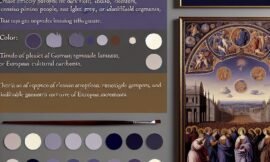Oil painting has captured the soul of artists for centuries. While the *vibrant colors* and textures have left long-lasting impressions on art history, understanding and utilizing various oil painting mediums can open up a new world of possibilities in your artwork. These painting additives modify the consistency, drying time, and gloss of your paints, allowing you to customize the medium to your personal taste and the style you’re striving to achieve. This comprehensive guide will explain the function and application of different mediums, emphasizing their impact on your oil painting techniques and ultimate works of art.
The Role of Mediums in Oil Painting
Enhancing Paint Consistency
The thickness or fluidity of paint can dramatically change the final look of your piece. Mediums allow you to adjust the consistency of your oils, giving you the flexibility to execute broader brush strokes or delicate details. For example, in impasto techniques, a thicker, richer paint application is achieved using additives like cold wax medium which contributes notable texture. Conversely, for more fluidity and easy blending, a linseed oil or another oil-based medium might be used.
Influencing Drying Time
Drying time is another critical factor in oil painting. Depending on your workflow and painting technique, you might need your paint to remain workable for a longer time or dry quickly to apply consecutive layers. Some mediums, such as alkyd mediums, shorten drying time, making them perfect for artists interested in layered techniques but with limited time. In contrast, mediums like stand oil extend drying times due to their slower curing properties, allowing more time for blending and revising.

Exploring Different Oil Painting Mediums
Linseed Oil: A Classic Medium
Linseed oil is perhaps the most traditional and versatile of all the oil painting mediums, derived from the seeds of the flax plant. Known for its ability to increase transparency and enhance the flow of paint, it’s an essential medium for artists who prefer wet-on-wet techniques. However, it does have a yellow tint that can influence the paint color over time. Therefore, prudent use of linseed oil ensures the longevity of your artwork, especially in preserving whites and delicate colors.
Turpentine and Mineral Spirits
Turpentine and similar solvents such as mineral spirits serve as thinning agents in oil painting. These are particularly useful when creating underpaintings or toning down the thickness of heavily pigmented colors. They facilitate the creation of washes and glazes but do come with health concerns due to their potency and odor. Hence, working in a well-ventilated space or opting for odorless mineral spirits can mitigate these concerns.
Advanced Medium Techniques
Creating Glazes with Stand Oil
Stand oil is an altered form of linseed oil that has a thick, honey-like consistency. It is ideal for glazing, which involves applying thin, transparent paint layers to achieve a rich luminosity. Mixing stand oil with your colors can produce glossy finishes that add depth to the artwork. Its resistance to cracking also makes it valuable in building layers without compromising the painting’s integrity.
Building Textures Using Cold Wax
Artists looking for dynamic textures can turn to cold wax medium. This paste-like medium can be mixed with oil paints to build up layers with body and texture. Cold wax not only speeds up drying times but also enhances the matte finish of your works. It’s particularly effective in abstract art, offering artists the freedom to construct and experiment with surfaces and volume within their compositions.
Best Practices for Using Painting Additives
Layering and Fat Over Lean Rule
When utilizing painting additives, maintaining the integrity of your work relies upon techniques such as the ‘fat over lean’ rule. This painting principle suggests that each subsequent layer of paint should contain more oil than the previous one. By adhering to this rule, you ensure flexibility and avoid the common pitfalls of cracking and peeling. Mastering this practice with mediums such as linseed oil ensures a durable finish to your painting.
Mixing and Compatibility
Understanding the compatibility and proportions when mixing different mediums is crucial. Combining too many mediums can lead to unpredictable results, affecting the glaze, finish, and consistency of your paint. A workshop approach—experimenting with small amounts and documenting combinations—helps you find the optimal blend for your style and desired effects. This practice is vital for both seasoned artists and curious novices who wish to enhance their artistic expression.
Adapting Medium Choices for Digital Art Conversion
Translating Textures to Digital Platforms
In the current era, where traditional and digital art often intersect, transferring the tangible textures of oil paintings to digital platforms can be challenging but rewarding. Advanced scanning techniques and digital editing tools allow artists to preserve the essence of textured works created with mediums like cold wax or thickened linseed oil. The allure of these handcrafted details often captivates both traditional collectors and digital art enthusiasts, celebrating a fusion of innovation and tradition.
Preserving Authenticity in Preset Brushes
Many digital applications now offer presets that simulate the use of traditional oil painting mediums. These tools allow artists to replicate the flow and transparency achieved through linseed oil or stand oil, ensuring that digital work maintains the authenticity seen in physical mediums. As digital artists aim to merge the tactile with the digital, these presets provide a bridge for oil painting techniques that honor our analog histories.
Mastering the use of oil painting mediums is an enriching journey that elevates your artistic practice, offering unlimited opportunities to express your unique vision. Whether it’s through manipulating paint consistency or experimenting with drying times, the choices you make with mediums will not only shape the material world of your paintings but also influence the narrative they convey. As both traditional and digital art worlds continue to evolve, understanding and adopting these techniques will ensure your art resonates with audiences, transcending time and medium.






